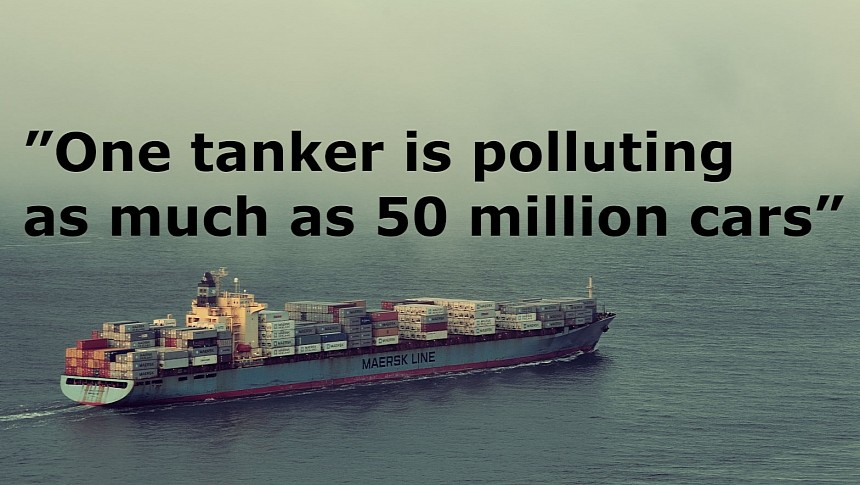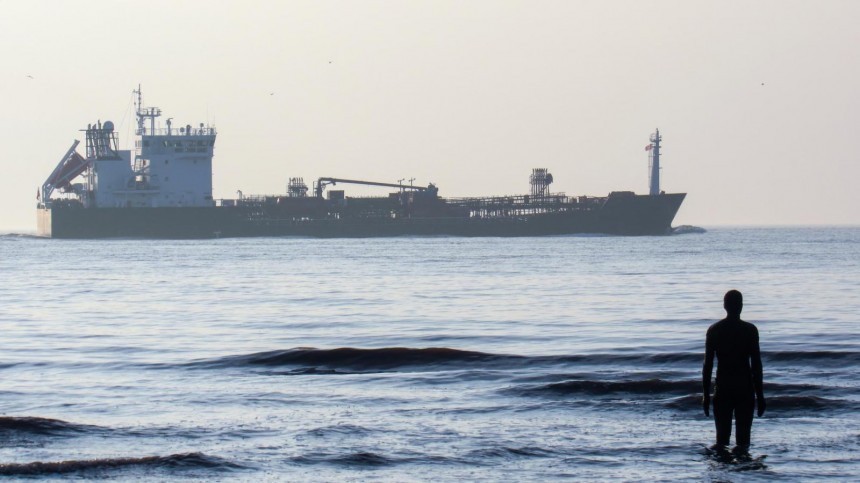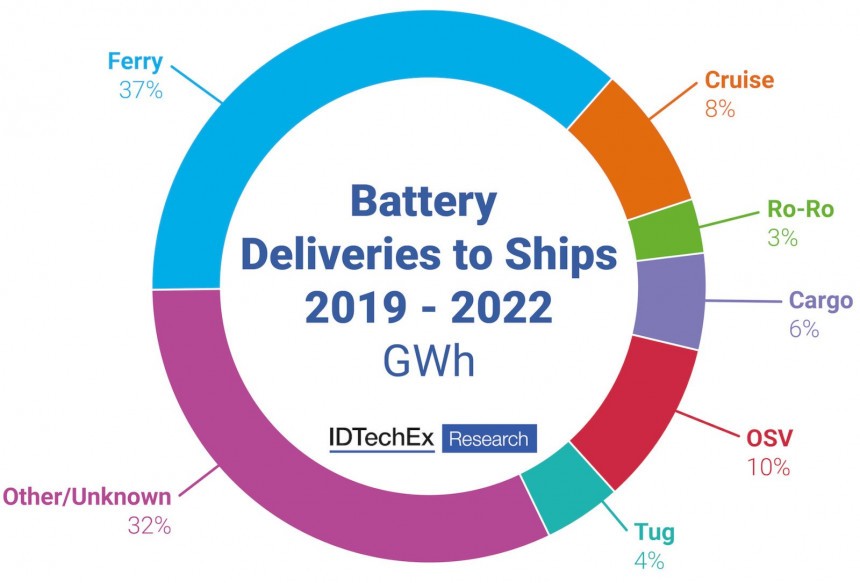I'm sure that by now, you've seen those social media posts claiming that "the sixteen largest ships emit the same amount of CO2 as all the world's cars" or "a seagoing container vessel is just as polluting as up to 50 million cars." It's not entirely fake news, as there is some truth in specific contexts. But make no mistake: ICE road vehicles remain the main culprit for the transportation sector's colossal pollution.
Just to put things in perspective, cars are responsible for 39% of transportation sector GHG emissions, while medium and heavy trucks along with buses and light commercial vehicles account for 35%. By comparison, ships' share is only 11%.
In 2009, the American Geophysical Union, the National Oceanic and Atmospheric Administration, and the University of Colorado released the study "Particulate emissions from commercial shipping: Chemical, physical, and optical properties." The study is based on research conducted in 2006 when scientists analyzed the exhaust from over 200 commercial vessels.
Their findings were worrisome, as researchers estimated that worldwide, ships emit yearly about 2.2 million pounds / 1 million tons of particulate pollution, including CO2 (the carbon dioxide driving global warming), NOx (the nitrogen oxides that sparked "Dieselgate"), SO2 (Sulfur dioxide), CO (Carbon monoxide), H2CO (Formaldehyde), and C2H4 (Ethylene), to name the most important ones.
Some researchers involved in this study made statements that became incendiary in mass media and social media. One of them is "Globally, shipping is thought to contribute almost as much primary PM as road traffic," where PM comes from "particulate matter," just like in the case of cars' internal combustion engines. This led the lead researcher, Daniel Lack, to state in an interview, "These ships are emitting as much [pollution] as 300m cars."
One of the study co-authors, James Corbett, who linked shipping particulate pollution to premature deaths among coastal populations, concluded that, hypothetically, 15 of the largest container ships could produce as much sulfur pollution as all the world's 760 million cars (at that time) if ships would use the dirtiest bunker fuel, while cars the cleanest fuel available. It was only a thought experiment, but little did he know what it would spark.
Of course, nobody can actually measure the quantity of polluting particles emitted by all the vessels, cars, and road vehicles in the world. These values are estimated based on complex mathematical models only some scientists comprehend. Therefore, you and I and 99.99% of people cannot verify if their findings are valid. Most of us tend to trust science, but we also tend to read between the lines and omit the details. Where the devil hides, as they say.
The" WOW" factor and the pressure to decarbonize the maritime sector
You can only imagine how the masses received those messages. Details like "hypothesis" or "sulfur pollution" became unnecessary because online headlines, Facebook posts, and Instagram memes must be as short as possible to get your attention. Luckily for fossil fuels proponents, slightly perverting those scientists' claims successfully distracted people's attention from cars' ICE accusations.The "one tanker is polluting as much as 50 million cars" became petrolheads' favorite argument when counteracting electroheads. Especially since it came from scientists, as many pointed out, missing the fact that it became fake news because of misinterpretation. The funny thing is that the same people who refuted global warming scientific facts were now sold to the scientists who involuntarily made ICE cars look much less guilty for pollution…
In return, because a ship's engine emitted more NOx than a vehicle's engine per unit of fuel, the NOx emissions of the maritime fleet were most likely higher than those of the global car fleet. This is natural because the bunker fuel used by vessels was much more polluting than the high-grade diesel used in cars and trucks. It's also true that diesel rose until "Dieselgate" in 2015, especially in Europe.
Regarding the SOx emissions, because the limit for road-vehicle fuels was several thousand times (!) lower than shipping fuel, CE Delft concluded that, indeed, the maritime fleet emits far more SOx than the global fleet and also that the sixteen largest container vessels (using the dirtiest bunker fuel) have similar SOx emissions to 50 million cars.
I don't know if this whole mess was slowing down EV adoption. But it definitely put real pressure on the maritime industry, which at that moment had almost no objective emissions standards. It all came down to the bunker fuel the vast majority of nearly 100,000 vessels in the world were using then. This is one of the dirtiest fuels, as it's merely a viscous residue after refining gasoline, diesel, and other petroleum products.
In 2013, the International Maritime Organization enacted mandatory measures for the maritime sector to improve propulsion technology efficiency and reduce GHG emissions. Many reports concluded that the climate impact of this industry was too much overlooked. What is the best description of shipping? If global shipping were a country, it would be the sixth largest producer of greenhouse gas emissions.
Keeping the business-as-always paradigm in this sector could lead to a 120% increase in GHG emissions by 2050, which is unacceptable. The latest report IMO GHG Study 2020 concluded that the rapid rise in maritime transport demand led to a 9.6% increase in emissions from 2012 to 2018, with an estimated 1,076 million tonnes. This is even though the carbon intensity was almost 30% better in 2018 than in 2012.
So, what are we going to do?
First of all, the dirty bunker fuel must go away for good, as the lifespan of a cargo vessel is around 20 years. Consider that such a vessel operates 24 hours a day for an average of 280 days a year. The largest ship diesel engine, with an output of more than 85,000 kW, can generate more than 5,000 tonnes of SOx emissions yearly. You do the math for a twenty-year interval.The industry is investing heavily in converting ships' diesel engines to use LNG (liquefied natural gas) because sulfur is reduced by 90%. But the IPCC (Intergovernmental Panel on Climate Change) experts warn that CO2-equivalent emissions reduction is only 10% over the entire lifecycle of ships. IMO expects that naval flows will most likely double until 2050, so the LNG is not valid, primarily since methane leakage related to natural gas extraction is already a big concern.
That's why the World Bank and the United Nations pressure governments and financial entities to develop regulations and heavily incentivize low-carbon fuels, like biofuels, green hydrogen, renewables, and synthetic fuels (e-fuels). But, as we've seen in other articles, developing feasible technical solutions for vessels and the infrastructure needed is too slow.
The problem is that 90% of global goods transport is over the sea because maritime transport has the best ton/kilometer cost ratio today. Half the more than 100,000 vessels fleet consists of container ships and big tankers, responsible for more than three-quarters of this sector's emissions. Converting them to hybrids will take a long time, and the costs will be very high due to the scarcity of critical raw materials and the fierce competition with other transport branches and the energy sector for lithium-ion batteries.
This is why alternative solutions, such as wind-assisted propulsion technologies, are gaining momentum. WindWings from BAR Technologies consists of large wing sails measuring up to 37.5 meters / 123 feet in height. They are said to help reduce fuel consumption by up to 30% - in the case of the first ship equipped with this device, it is expected that WindWings will save 1.5 tonnes of fuel on an average global route.
The eSAIL system from bound4blue or the Norsepower Rotor Sail uses the Magnus effect, which harnesses the wind to generate thrust for the ship. Theoretically, they provide up to 40% fuel consumption and emissions reduction. Besides, a wide range of tankers and heavy carriers with at least ten years of service remaining can be conveniently retrofitted to these technologies.
The good news is that the maritime industry is well aware of its responsibility to slash emissions, and the most significant players are already investing big money in low-carbon technologies. The bad news is that most experts in this field believe the industry will not be able to reduce its greenhouse gas emissions to net zero by 2050.
At least, road transport can be entirely electrified by then if we stop finding excuses. Three-quarters of GHG emissions come from passenger cars, light commercial vehicles, medium and heavy trucks, buses, and two- and three-wheelers. Shipping's share is just 11-12%, so I can live with it not becoming entirely zero-emissions because at least its pollution is hundreds of miles away from our cities.








